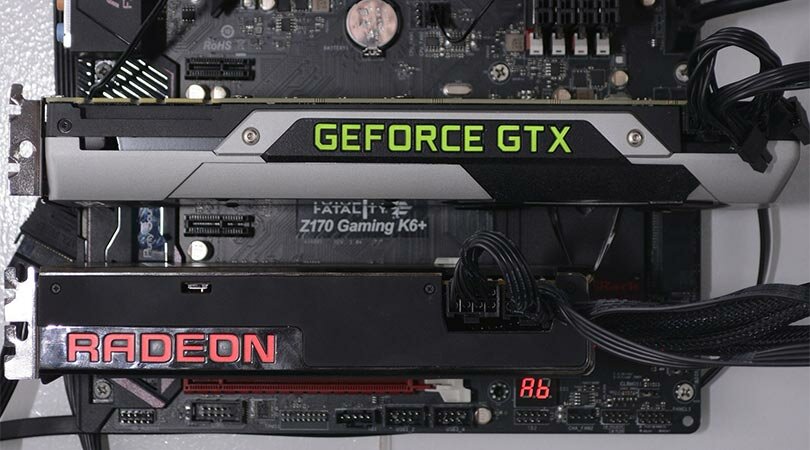PC games are getting more graphic-intensive with each passing day, and in order to have those stunning graphics on your display screen, you need GPUs more powerful than ever before.
A few years ago, 4 GB graphics cards were only bought by the PC enthusiasts, and most PC games didn’t use to require this much power.
But now 4 GB GPUs are just the middle-tier in the GPU hierarchy.
So, if you already have a 2 GB graphics card installed in your PC and you want to upgrade it, two options come before you.
First, you can buy a new 4/6 GB graphics card (after getting rid of your existing one) and install it on your PC. The other thing you can do here is getting another 2 GB graphics card, and do a multi-GPU setup.
If you follow the second route, you’ll have to spend less than the first one.
Through the multi-GPU configurations, you can have as much as four graphics card in a single system. Then, you can link them together to have 4 times more power (assuming all of them have the same VRAM).
So far so good, right?
But in case you’ve decided to go with a multi-GPU setup, a small dilemma arises. It’s because both Nvidia and AMD (two giants in the GPU market) offer this technology but with different names.
For AMD, this technology is called Crossfire while the Nvidia has named their version SLI (Scalable Link Interface).
In this post, we’re going to find how to both of them work, and more importantly, are they worth it in 2020?
First, we’ll talk about the similarities. Both of these technologies have two common modes – SFR and AFR.
Split Frame Rendering (SFR): In this method, every frame (that’s going to be rendered) is divided horizontally into as many pieces as the number of GPUs you have attached, and then sent to those cards. After this, each graphics card will process the portion of the frame given to it.
Alternate Frame Rendering (AFR) – In AFR mode, rather than splitting a single frame, graphics cards process frame in an alternate manner. So, if you have three graphics card in this setup, GPU 1 will process Frame 1, 4, 7 and 10; GPU 2 will get Frame 2, 5, 8, and 11; while the Frame 3, 6, 9, and 12 will go to the GPU 3.
In addition to these modes, there’s a popular SLI-only mode called SLI Anti-aliasing. This method is slightly different the other two mentioned above because while the SFR and AFR methods work on rendering frames as fast as possible, SLI anti-aliasing works on the better image quality by splitting the anti-aliasing workload between all the GPUs on your PC.
Having done with all the similarities between SLI and Crossfire, here are some differences.
Firstly, in order to make SLI work, you’ll need the same graphics cards. It means that if you currently have a Gigabyte GTX 1060 graphics card installed in your PC, you can add another GTX 1060 (even if it’s from the MSI) but not a GTX 1070. The limitation in AMD graphics cards, on the other hand, is slightly relaxed because you can link up two graphics cards as long as they have the same architecture.
The second difference is that, in SLI, you have to use an SLI bridge in order to link up your graphics cards, while the crossfire technology uses PCIe 3.0 for the communication between these cards.
The third and most important one is the price. Since the SLI technology specifically requires the SLI-certified motherboards, it’s more costly than the crossfire technology that can be employed even in midrange builds.
Disadvantages of Multi-GPU Configurations
A few years ago, Multi-GPU configs were really on fire and many game developers were optimizing them specifically for SL/crossfire setups. But in recent times, the popularity of those setups is somewhat diminished and this the reason why, nowadays, game developers don’t optimize their games for these setups as they used to do.
One of the biggest disadvantages of these setups is the cost. Although Two GTX 1070s cost slightly more than a single GTX 1080, and apparetly it makes sense to buy Two GTX 1070 instead of one GTX 1080, but when you take notice of the extra cost in the form of a bigger power supply, bigger case to accommodate both GPUs, more case fans to cool down that case, and an SLI-certified motherboard (for Nvidia only though), it pretty much balances the equation.
Scenarios where Mult-GPUs are worth it
The following are the only two scenarios where SLI/crossfire make sense in 2020.
The first case is if you’ve got very old hardware and any latest GPU would be useless. The second case is if you want to go to the other extreme of PC gaming, like 4K gaming on a triple-monitor setup where a single GPU won’t get the job done consistently no matter how powerful it is.
If any of those above conditions don’t apply to you, it’s simply useless to go with an SLI/Crossfire configuration.
Read more: Best compact GPUs for Mini-ITX builds
